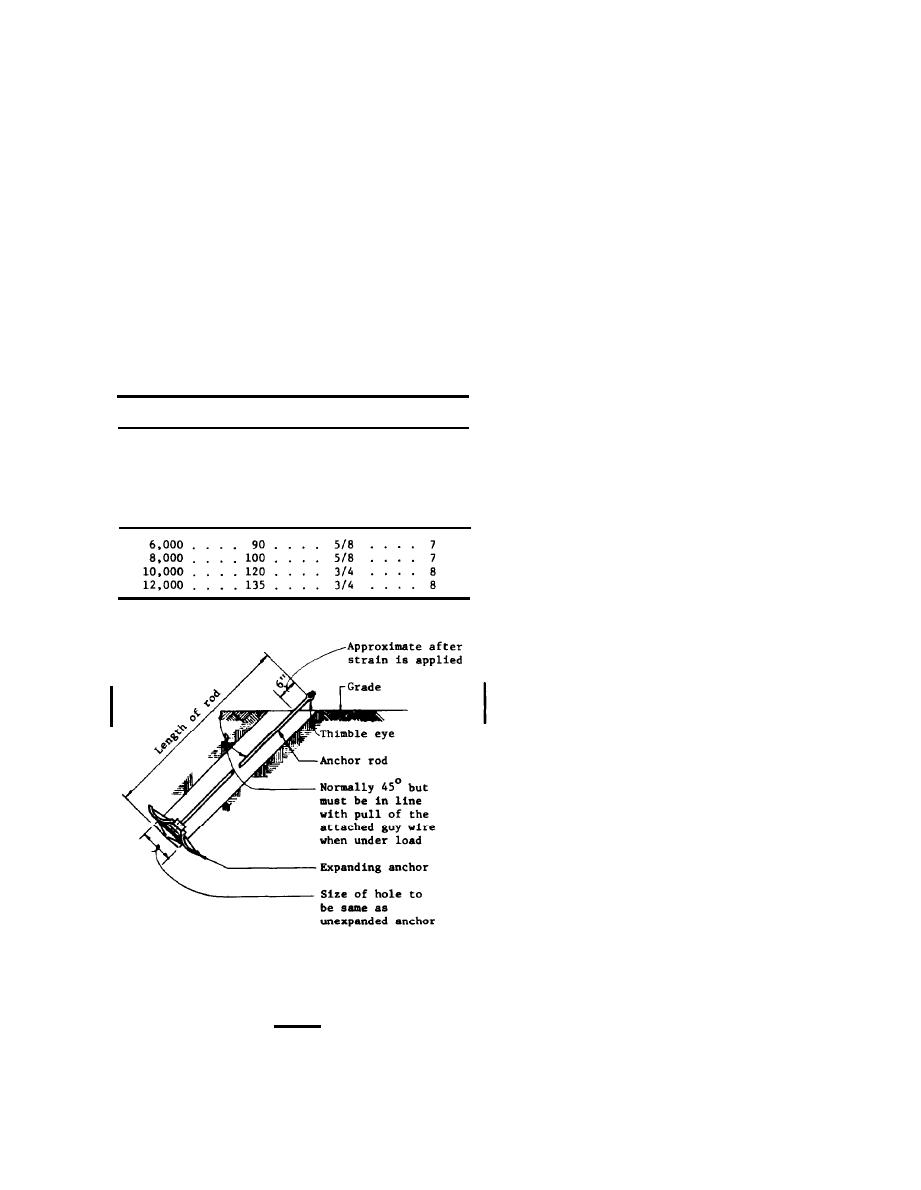
TM
5-811-1/AFJMAN
32-1080
panding anchors, with extra long anchor rods
at 25,000 pounds and a l-inch diameter rod rated
reaching firm underlying soil, may be acceptable
at 40,000 pounds.
in some cases. Multihelix screw anchors can also
(6) Guy markers. The purpose of guy markers
be installed in swampy soils when this type of
is to provide a substantial and conspicuous indica-
anchor can provide the required holding power.
tion to pedestrians that an impediment to passage
Three-eye thimbles will be provided on all anchor
exists. Markers should be yellow to provide the
rods. This permits use of individual down guys for
greatest visibility, unless gray or other finishes
primary, secondary, and communication circuits
are approved for the installation.
and anchors must provide adequate strength to
b. Installation. Guys are installed to balance
support all of these loads.
line tensions and are therefore appropriate where
(5) Rod assemblies. Rod assemblies must meet
lines begin, end, or where lines change direction.
ANSI C135.2 tensile loading tests. A 5/8-inch
(1) Types. Most installations utilize down
diameter rod is rated at about 16,000 pounds
guys, wherein the guy wire is led away from the
breaking strength, a 3/4-inch diameter rod is
pole at a 45 degree angle down to an anchor. Since
rated at about 23,000 pounds, and a l-inch diame-
this configuration can interfere with traffic, span
ter rod is rated at about 36,000 pounds, but some
or sidewalk guys may be necessary to shorten guy
manufacturers offer a 3/4-inch diameter rod rated
leads. Head guys will be provided at heavily
loaded corners to reduce tension in a corner span
Ratingsa
and strain on the corner pole. Dead-end guys will
be provided in long straight lines at not less than
Holding
every 2,500 feet to limit the effects from line
Minimum
Minimum
power
Minimum
anchor
breaks. Storm guys will be provided in long
rod
in
rod
area
straight lines at not less than every 5,000 feet to
diameter
ordinary
length
square
inches
soil
feet
reinforce lines against storm effects. Various types
inches
pounds
of guys are shown schematically on figure 6-8.
Figure 6-9 shows down and span guy require-
ments in more detail. Although several guys are
shown on the down guy detail, a single guy is
permissible when adequate holding strength is
provided.
a
From REA Bulletin 43-5.
(2) Guy lead angle and strength requirements.
A lead angle (lead) is the angle that a guy wire
makes with the center line of the pole. As can be
seen on figure 6-10, the greater the lead angle the
larger the horizontal component and thus the
lower the minimum breaking strength needed to
provide the necessary holding capacity to balance
conductor tension. However, for down guys, the
greater the lead angle the more the guy interferes
with other use of the space. Lead angles from 45
degrees (optimum) to 15 degrees (minimum) will be
used to balance conductor tensions of 70 to 25
percent of the guy wire minimum rated breaking
strength. Where clearances over pedestrian areas
require sidewalk guys, the holding capacity will be
greatly decreased because there is a bending mo-
ment on the pole at strut height; therefore, side-
walk guys will be installed only when no other
method is feasible or the conductor tension is
Note:
Projection of anchor rods above grade may be
increased to a maximum of 12 inches in planting
minimal. A computation for in-line guy strength
beds or other locations where necessary to
requirements is shown on figure 6-10. Figure 6-11
prevent burying the eye.
gives an example of a pole strength analysis.
(3) Bisect angle guys versus in-line guys. The
maximum permitted angle of line deviation for a
US Army Corps of Engineers
single angle guy installation (one guy installed on
the bisect of line angle) is 45 degrees. For greater
Figure 6-7. Expanding Anchor Details.
6-15



 Previous Page
Previous Page
